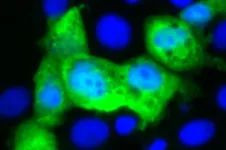Antimicrobial stewardship programs essential for preventing C. difficile in hospitals
Medical organizations update guidance to limit persistent and impactful infections
2023-04-12
(Press-News.org) ARLINGTON, Va. (April 12, 2023) — Five medical organizations say it is essential that hospitals establish antimicrobial stewardship programs to prevent Clostridioides difficile (C. difficile) infections. These infections, linked to antibiotic use, cause difficult-to-treat diarrhea, longer hospital stays, and higher costs. C. difficile infections are fatal for more than 12,000 people in the United States each year.
Strategies to Prevent Clostridioides difficile Infections in Acute Care Hospitals: 2022 Update, gives evidence-based, practical recommendations so that acute care hospitals can effectively identify C. difficile infections and prevent the spread of this dangerous bacterium. This document, published today in the journal Infection Control & Hospital Epidemiology, is the most recent expert guidance in the series known collectively as the Compendium.
“C. difficile is an urgent health threat, and hospitals need system-wide commitment to stop it,” said lead author Larry K. Kociolek, MD, Vice President of System Preparedness, Prevention, and Response at Lurie’s Children’s Hospital of Chicago and a member of the Society for Healthcare Epidemiology of America (SHEA). “Because the use of antibiotics is strongly associated with C. difficile infections, antimicrobial stewardship – an approach to making sure these drugs are prescribed and used appropriately – is a strong first-line defense.”
C. difficile causes more than 450,000 infections per year in the U.S., and CDC has identified it as a public health threat that requires urgent and aggressive action. Patients who had C. difficile during a hospital stay are more likely to have part or all of their colon removed and are more likely to be discharged to a nursing home.
Diagnostic stewardship for appropriate use and interpretation of C. difficile tests also was identified as an essential practice. While healthcare-associated cases have leveled off in recent years, community-associated C. difficile cases have risen, increasing the risk to hospitalized patients and enhancing the need for quick and accurate diagnosis.
The updated guidance also emphasizes assessment of the adequacy of room cleaning and addresses procedures for cleaning equipment and the environment of patients with C. difficile. The authors also address the need for timely alerts when patients are newly diagnosed; data reporting; education of environmental services personnel, administrators, patients and families; and additional steps hospitals can take if C. difficile incidence remains high after implementing essential practices.
This document updates the 2014 Strategies to Prevent Clostridium difficile Infections in Acute Care Hospitals. The Compendium, first published in 2008, is sponsored by the Society for Healthcare Epidemiology (SHEA). It is the product of a collaborative effort led by SHEA, with the Infectious Diseases Society of America, the Association for Professionals in Infection Control and Epidemiology, the American Hospital Association, and The Joint Commission, with major contributions from representatives of several organizations and societies with content expertise. The Compendium is a multiyear, highly collaborative guidance-writing effort by over 100 experts from around the world.
Upcoming Compendium updates will include strategies to prevent catheter-associated urinary tract infections, methicillin-resistant Staphylococcus aureus infections, and surgical site infections. Strategies for preventing central line-associated bloodstream infections, ventilator and non-ventilator associated pneumonia and events, and strategies to prevent healthcare-associated infections through hand hygiene were recently updated as well. Each Compendium article contains infection prevention strategies, performance measures, and approaches to implementation. Compendium recommendations are derived from a synthesis of systematic literature review, evaluation of the evidence, practical and implementation-based considerations, and expert consensus.
###
About Infection Control & Hospital Epidemiology
Published through a partnership between the Society for Healthcare Epidemiology of America and Cambridge University Press, Infection Control & Hospital Epidemiology provides original, peer-reviewed scientific articles for anyone involved with an infection control or epidemiology program in a hospital or healthcare facility. ICHE is ranked 24th out of 94 Infectious Disease Journals in the latest Web of Knowledge Journal Citation Reports from Thomson Reuters.
About the Society for Healthcare Epidemiology of America (SHEA)
The Society for Healthcare Epidemiology of America (SHEA) is a professional society representing more than 2,000 physicians and other healthcare professionals around the world who possess expertise and passion for healthcare epidemiology, infection prevention, and antimicrobial stewardship. The society’s work improves public health by establishing infection-prevention measures and supporting antibiotic stewardship among healthcare providers, hospitals, and health systems. This is accomplished by leading research studies, translating research into clinical practice, developing evidence-based policies, optimizing antibiotic stewardship, and advancing the field of healthcare epidemiology. SHEA and its members strive to improve patient outcomes and create a safer, healthier future for all. Visit SHEA online at shea-online.org, facebook.com/SHEApreventingHAIs and twitter.com/SHEA_Epi.
END
ELSE PRESS RELEASES FROM THIS DATE:
2023-04-12
LA JOLLA—(April 12, 2023) Brains are like puzzles, requiring many nested and codependent pieces to function well. The brain is divided into areas, each containing many millions of neurons connected across thousands of synapses. These synapses, which enable communication between neurons, depend on even smaller structures: message-sending boutons (swollen bulbs at the branch-like tips of neurons), message-receiving dendrites (complementary branch-like structures for receiving bouton messages), and power-generating mitochondria. To create a cohesive brain, all these pieces must be accounted for.
However, in the aging brain, these ...
2023-04-12
A new study shows promise for reducing risky drinking among Army National Guard members over the long term, potentially improving their health and readiness to serve.
The number of days each month that Guard members said they had been binge-drinking dropped by up to half, according to the new findings by a University of Michigan team published in the journal Addiction.
The drop happened over the course of a year among Guard members who did multiple brief online education sessions designed for members of the military, and among those who did an initial online education session followed by supportive ...
2023-04-11
WASHINGTON — Throughout the Arctic, fallen trees make their way from forests to the ocean by way of rivers. Those logs can stack up as the river twists and turns, resulting in long-term carbon storage. A new study has mapped the largest known woody deposit, covering 51 square kilometers (20 square miles) of the Mackenzie River Delta in Nunavut, Canada, and calculated that the logs store about 3.4 million tons (about 3.1 million metric tons) of carbon.
“To put that in perspective, that’s about two and a half million ...
2023-04-11
According to Bening Mayanti's doctoral dissertation at the University of Vaasa, the use of life cycle assessment combined with economic models can help companies to take steps toward the circular economy.
– We often hear claims about some solutions being circular, sustainable, or green. Instead of blindly accepting those claims, we should ask justifications, ‘How so?’ says Mayanti, who publicly defended her dissertation on Wednesday, 5 April.
Before deciding on circular economy solutions and building supply chains, it is worth doing a careful analysis. ...
2023-04-11
A new perspective published in the journal Nature Chemical Biology uncovers a previously unknown biochemical recycling process in animals. The authors review a flurry of recent papers demonstrating that animals extensively recycle biochemical waste to produce novel chemicals that play key roles in biology, from regulating behavior to development and aging.
These studies show that the genes previously thought to code for carboxylesterases, enzymes that hydrolyze esters, actually play a pivotal role in assembling a wide range of new metabolites from building blocks generally considered “cellular waste.” Surprisingly, the so-called carboxylesterases were found to contribute ...
2023-04-11
Global supply chains are immense feats of technological and organizational sophistication. They are also, as the onset of the Covid-19 pandemic showed, vulnerable to unexpected developments. Will that change as artificial intelligence becomes a bigger part of supply chains? And what will happen to workers in the process?
MIT Professor Yossi Sheffi explores these topics in a new book, “The Magic Conveyor Belt: AI, Supply Chains, and the Future of Work,” published by MIT’s CTL Media. Sheffi, the Elisha Gray II Professor of Engineering ...
2023-04-11
Oak Ridge National Laboratory researchers have developed an online resource to help consumers understand the electric vehicle tax credits available through the Inflation Reduction Act.
Located on the Department of Energy’s fueleconomy.gov website, the tool shows eligible vehicle models along with the corresponding federal tax credit.
The new clean vehicle tax credit is for purchases of all-electric, plug-in hybrid electric and fuel cell electric vehicles in 2023 and beyond. A separate credit is available for eligible used vehicles purchased in 2023 or after. Information on credits for vehicles purchased before ...
2023-04-11
“To our knowledge, this is the first functional study of POLDIP2 in retinal cells to understand its potential role in AMD.”
BUFFALO, NY- April 11, 2023 – A new research paper was published in Aging (listed by MEDLINE/PubMed as "Aging (Albany NY)" and "Aging-US" by Web of Science) Volume 15, Issue 6, entitled, “Knockout of AMD-associated gene POLDIP2 reduces mitochondrial superoxide in human retinal pigment epithelial cells.”
Genetic and epidemiologic studies have significantly advanced our ...
2023-04-11
Every year, norovirus causes hundreds of millions of cases of food poisoning — and the deaths of at least 50,000 children — yet there exists no real way to control it. The virus has proven exceptionally difficult to study in the lab, and scientists have struggled to develop effective vaccines and drugs.
A new study at Washington University School of Medicine in St. Louis describes a creative way to make a vaccine against norovirus by piggybacking on the highly effective vaccines for rotavirus, an unrelated virus that also causes diarrhea.
The ...
2023-04-11
ITHACA, N.Y. – The demand for battery-grade lithium, nickel, cobalt, manganese and platinum will climb steeply as vehicle electrification speeds up and nations work to reduce greenhouse gas emissions through mid-century. This surge in demand will also create a variety of economic and supply-chain problems, according to new Cornell University research published in Nature Communications.
In the new paper, senior author Fengqi You, professor in energy systems engineering, and his colleagues examined 48 countries that are committed to playing a strong role in electrifying transportation, including the U.S., China and India.
Under ...
LAST 30 PRESS RELEASES:
[Press-News.org] Antimicrobial stewardship programs essential for preventing C. difficile in hospitals
Medical organizations update guidance to limit persistent and impactful infections






